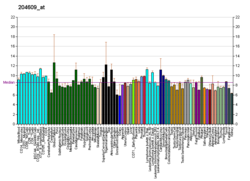Protein-coding gene in humans
| CCDC85B |
|---|
|
| Identifiers |
|---|
| Aliases | CCDC85B, DIPA, coiled-coil domain containing 85B |
|---|
| External IDs | OMIM: 605360; MGI: 2147607; HomoloGene: 4989; GeneCards: CCDC85B; OMA:CCDC85B - orthologs |
|---|
| Gene location (Human) |
|---|
 | | Chr. | Chromosome 11 (human)[1] |
|---|
| | Band | 11q13.1 | Start | 65,890,673 bp[1] |
|---|
| End | 65,891,635 bp[1] |
|---|
|
| Gene location (Mouse) |
|---|
 | | Chr. | Chromosome 19 (mouse)[2] |
|---|
| | Band | 19|19 A | Start | 5,503,208 bp[2] |
|---|
| End | 5,507,922 bp[2] |
|---|
|
| RNA expression pattern |
|---|
| Bgee | | Human | Mouse (ortholog) |
|---|
| Top expressed in | - amygdala
- Brodmann area 9
- right frontal lobe
- nucleus accumbens
- putamen
- apex of heart
- caudate nucleus
- Region I of hippocampus proper
- cingulate gyrus
- anterior cingulate cortex
|
| | Top expressed in | - anterior horn of spinal cord
- facial motor nucleus
- endothelial cell of lymphatic vessel
- epithelium of lens
- otolith organ
- utricle
- prefrontal cortex
- hippocampus proper
- primary motor cortex
- cingulate gyrus
|
| | More reference expression data |
|
|---|
| BioGPS | 
 | | More reference expression data |
|
|---|
|
| Gene ontology |
|---|
| Molecular function | | | Cellular component | - cytoplasm
- centrosome
- cytoskeleton
- nucleus
- microtubule organizing center
| | Biological process | - regulation of growth
- cell differentiation
- negative regulation of fat cell differentiation
- negative regulation of transcription, DNA-templated
- regulation of transcription, DNA-templated
- negative regulation of cell growth
- transcription, DNA-templated
| | Sources:Amigo / QuickGO |
|
| Orthologs |
|---|
| Species | Human | Mouse |
|---|
| Entrez | | |
|---|
| Ensembl | | |
|---|
| UniProt | | |
|---|
| RefSeq (mRNA) | | |
|---|
| RefSeq (protein) | | |
|---|
| Location (UCSC) | Chr 11: 65.89 – 65.89 Mb | Chr 19: 5.5 – 5.51 Mb |
|---|
| PubMed search | [3] | [4] |
|---|
|
| Wikidata |
| View/Edit Human | View/Edit Mouse |
|
Coiled-coil domain-containing protein 85B is a protein that in humans is encoded by the CCDC85B gene.[5][6][7]
Function
Hepatitis delta virus (HDV) is a pathogenic human virus whose RNA genome and replication cycle resemble those of plant viroids. Delta-interacting protein A (DIPA), a cellular gene product, has been found to have homology to hepatitis delta virus antigen (HDAg). DIPA interacts with the viral antigen, HDAg, and can affect HDV replication in vitro.[7]
Interactions
CCDC85B has been shown to interact with:
References
- ^ a b c GRCh38: Ensembl release 89: ENSG00000175602 – Ensembl, May 2017
- ^ a b c GRCm38: Ensembl release 89: ENSMUSG00000095098 – Ensembl, May 2017
- ^ "Human PubMed Reference:". National Center for Biotechnology Information, U.S. National Library of Medicine.
- ^ "Mouse PubMed Reference:". National Center for Biotechnology Information, U.S. National Library of Medicine.
- ^ Brazas R, Ganem D (Oct 1996). "A cellular homolog of hepatitis delta antigen: implications for viral replication and evolution". Science. 274 (5284): 90–4. Bibcode:1996Sci...274...90B. doi:10.1126/science.274.5284.90. PMID 8810253. S2CID 20743492.
- ^ Bezy O, Elabd C, Cochet O, Petersen RK, Kristiansen K, Dani C, et al. (Mar 2005). "Delta-interacting protein A, a new inhibitory partner of CCAAT/enhancer-binding protein beta, implicated in adipocyte differentiation". The Journal of Biological Chemistry. 280 (12): 11432–8. doi:10.1074/jbc.M411741200. PMID 15644333.
- ^ a b "Entrez Gene: CCDC85B coiled-coil domain containing 85B".
- ^ a b c d Rual JF, Venkatesan K, Hao T, Hirozane-Kishikawa T, Dricot A, Li N, et al. (Oct 2005). "Towards a proteome-scale map of the human protein-protein interaction network". Nature. 437 (7062): 1173–8. Bibcode:2005Natur.437.1173R. doi:10.1038/nature04209. PMID 16189514. S2CID 4427026.
External links
Further reading
- Robertson HD (Oct 1996). "How did replicating and coding RNAs first get together?". Science. 274 (5284): 66–7. Bibcode:1996Sci...274...66R. doi:10.1126/science.274.5284.66. PMID 8848724. S2CID 37715470.
- Long M, de Souza SJ, Gilbert W (May 1997). "Delta-interacting protein A and the origin of hepatitis delta antigen". Science. 276 (5313): 824–5. doi:10.1126/science.276.5313.824. PMID 9115212.
- Schumacher B, Schertel C, Wittenburg N, Tuck S, Mitani S, Gartner A, et al. (Feb 2005). "C. elegans ced-13 can promote apoptosis and is induced in response to DNA damage". Cell Death and Differentiation. 12 (2): 153–61. doi:10.1038/sj.cdd.4401539. PMID 15605074.
- Rual JF, Venkatesan K, Hao T, Hirozane-Kishikawa T, Dricot A, Li N, et al. (Oct 2005). "Towards a proteome-scale map of the human protein-protein interaction network". Nature. 437 (7062): 1173–8. Bibcode:2005Natur.437.1173R. doi:10.1038/nature04209. PMID 16189514. S2CID 4427026.
- Lim J, Hao T, Shaw C, Patel AJ, Szabó G, Rual JF, et al. (May 2006). "A protein-protein interaction network for human inherited ataxias and disorders of Purkinje cell degeneration". Cell. 125 (4): 801–14. doi:10.1016/j.cell.2006.03.032. PMID 16713569. S2CID 13709685.
- Du X, Wang Q, Hirohashi Y, Greene MI (Dec 2006). "DIPA, which can localize to the centrosome, associates with p78/MCRS1/MSP58 and acts as a repressor of gene transcription". Experimental and Molecular Pathology. 81 (3): 184–90. doi:10.1016/j.yexmp.2006.07.008. PMID 17014843.


















